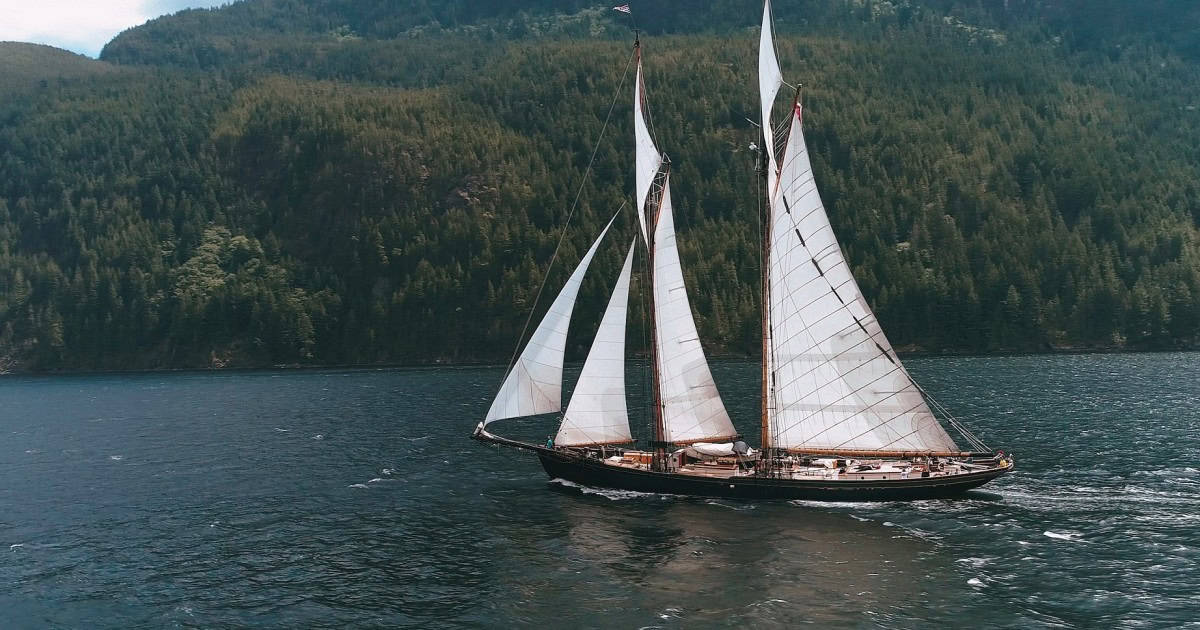The Pacific Northwest is a paradise for sailors, offering a rich tapestry of breathtaking landscapes, diverse wildlife, and unique coastal communities. From the sheltered waters of Puget Sound and the Gulf Islands to the dramatic fjords of Desolation Sound and the expansive Columbia River, this region has something for every boating enthusiast. With its mix of tranquil bays, vibrant harbor towns, and opportunities for adventure both on and off the water, the Pacific Northwest is more than just a destination—it’s an experience.
Read: Kayaking Puget Sound
Whether you’re navigating the winding waterways of the San Juan Islands, cruising past the forested cliffs of the Sunshine Coast, or exploring the historical charm of the Columbia River, each stop offers its own allure. This guide highlights the must-visit sailing spots across the region, complete with tips for navigating, anchoring, and enjoying the best activities and attractions along the way. You could consider investing in a custom yacht for your journey, or chartering a boat when you’re there for the peace of mind of traveling with an experienced crew. Prepare to set sail for an unforgettable journey through one of the most spectacular maritime landscapes in the world.
Sailing Washington State
San Juan Islands Sailing: A Wildlife and Coastal Gem
The San Juan Islands, located off the coast of Washington State, are a sailor’s paradise. This archipelago of over 170 islands boasts tranquil waters, stunning natural beauty, and abundant marine life. It’s a prime spot for whale watching, with orcas and humpback whales often spotted near Orcas Island. Spring and summer are ideal for sailing, with calm waters and long daylight hours.
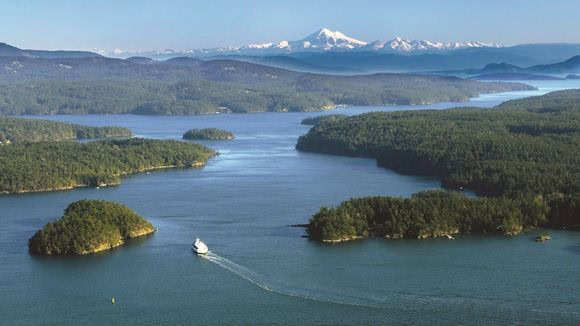
Key Features for Sailors
- Navigation Tips: Waters are generally protected and calm, but sailors should watch for tidal currents, especially around Cattle Pass and Rosario Strait. A detailed chart of the San Juan Islands is essential for safely navigating the smaller inlets and channels.
- Anchorages and Marinas:
- Friday Harbor: Full-service marina with fuel, water, showers, and nearby shops.
- Roche Harbor: Offers moorage, dining options, and historic charm.
- Blind Bay: A quieter anchorage, ideal for peaceful overnight stays.
- Best Times to Visit: May through September offers the best sailing conditions, with warm temperatures and calm seas.
Activities and Attractions
- On the Water: Kayak among kelp forests or take a guided whale-watching tour for close encounters with orcas, humpback whales, and dolphins.
- On Land: Explore Lime Kiln Point State Park, known as one of the best land-based whale-watching spots in the world. Visit Friday Harbor’s art galleries and enjoy fresh seafood at waterfront restaurants.
- Wildlife Watching: Spot seals, sea lions, and bald eagles year-round, with prime whale-watching from May to October.
Local Tips
- Provisions and Supplies: Friday Harbor offers several grocery stores and marine supply shops. Stock up before heading to more remote anchorages.
- Events and Festivals: Check out the San Juan Island Lavender Festival in summer or the Friday Harbor Film Festival in autumn.
- Environmental Considerations: Follow local guidelines for safe whale watching and respect the “no-go” zones near sensitive marine habitats.
Puget Sound Sailing: A Tapestry of Bays, Islands, and Coastal Towns
Puget Sound, located south of the San Juan Islands, is a vibrant and varied sailing destination. With its intricate network of inlets, bays, and islands, this region offers a mix of bustling harbor cities, quiet anchorages, and stunning natural scenery. Sheltered waters and a well-developed network of marinas make Puget Sound ideal for sailors of all experience levels. From the urban excitement of Seattle to the tranquil beauty of small coastal towns, Puget Sound provides a diverse and rewarding experience.
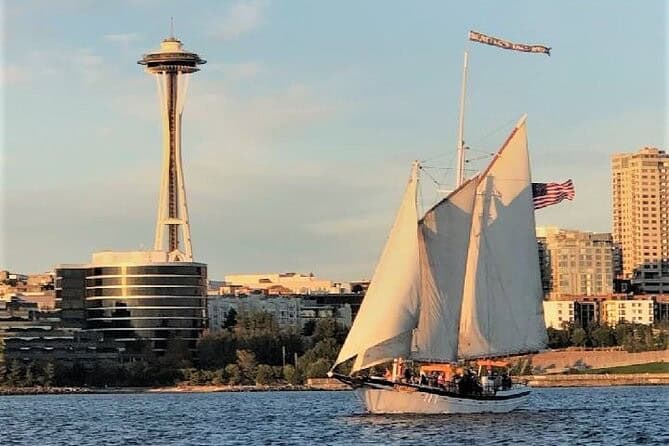
Key Features for Sailors
- Navigation Tips: The sound’s waters are calm and protected, but tidal currents can be strong, especially near Tacoma Narrows and Deception Pass. Sailors should use updated charts like NOAA 18440 and monitor tides and weather forecasts regularly.
- Anchorages and Marinas:
- Elliott Bay (Seattle): Offers full-service marinas like Bell Harbor and Elliott Bay Marina, with easy access to Seattle’s attractions.
- Port Townsend: A historic maritime hub at the sound’s northern entrance, offering excellent moorage and repair facilities.
- Gig Harbor: A picturesque harbor with sheltered anchorage, quaint shops, and waterfront dining.
- Blake Island Marine State Park: A peaceful anchorage accessible only by boat, with hiking trails and a chance to learn about local Native American culture.
- Best Times to Visit: May through September offers warm, dry weather with steady winds. Winter sailing is possible but requires preparation for cooler temperatures and frequent rain.
Activities and Attractions
- On the Water: Puget Sound’s calm waters are perfect for leisurely sailing, fishing, and crabbing. The islands and inlets are also ideal for kayaking and paddleboarding, offering up-close exploration of the region’s coves and beaches.
- On Land:
- Seattle: Dock in Elliott Bay and explore iconic attractions like Pike Place Market, the Space Needle, and the Museum of History & Industry (MOHAI).
- Bainbridge Island: Just across from Seattle, this charming island offers wineries, boutique shops, and the popular Bloedel Reserve gardens.
- Tacoma: Visit the Museum of Glass and enjoy views of Mount Rainier from the waterfront.
- Whidbey Island: Known for its scenic beauty, Whidbey offers quiet beaches, hiking trails, and charming towns like Coupeville.
- Wildlife Watching: Puget Sound is rich with marine life, including orcas, harbor seals, and sea lions. Bald eagles and herons are frequently seen along the shoreline. Spring and summer bring opportunities to spot migrating gray whales.
Local Tips
- Provisions and Supplies: Seattle, Tacoma, and Port Townsend are the best locations to stock up on fuel, groceries, and marine supplies. Smaller towns like Bainbridge Island and Gig Harbor offer limited services but plenty of charm.
- Events and Festivals: Time your visit to coincide with events like Seattle’s Wooden Boat Festival in July or Port Townsend’s Race to Alaska in June for a unique nautical experience.
- Environmental Considerations: Puget Sound is a delicate ecosystem. Follow strict pump-out regulations and minimize your wake near sensitive habitats to protect marine life and coastal shorelines.
Strait of Juan de Fuca Sailing: Gateway to the Pacific Northwest
The Strait of Juan de Fuca is a vital waterway connecting the Pacific Ocean to the inland waters of Puget Sound and the Salish Sea. Stretching between Washington State’s Olympic Peninsula and Vancouver Island, this strait is not only a busy maritime corridor but also a scenic region rich with wildlife and dramatic coastal landscapes. For sailors, it serves as both a destination and a passage, offering rugged beauty, thrilling sailing conditions, and access to charming coastal towns.
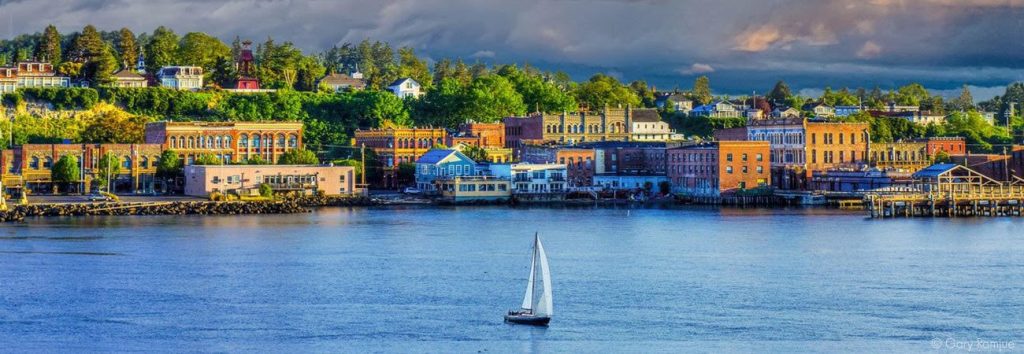
Key Features for Sailors
- Navigation Tips: The strait can be challenging due to strong winds, tidal currents, and occasional fog. Mariners should consult tide charts and weather forecasts closely, as conditions can change rapidly. Charts 18460 and 3441 are essential for navigating this area. Watch for large commercial vessels transiting the strait, particularly near shipping lanes.
- Anchorages and Marinas:
- Neah Bay: A sheltered anchorage at the strait’s western entrance, offering moorage and fuel. It’s a great place to rest before or after crossing into the open Pacific.
- Port Angeles: A full-service marina on the southern shore with fuel, water, and access to shops and restaurants.
- Sooke Harbour: Located on Vancouver Island, this harbor is well-protected and perfect for exploring the nearby wilderness.
- Best Times to Visit: Summer months (June to September) offer the most predictable weather, with lighter winds and calmer seas. Spring and fall can still be beautiful but bring greater challenges with stronger winds and increased rainfall.
Activities and Attractions
- On the Water: Sailors can enjoy thrilling conditions, particularly in the western strait, where the Pacific swells meet tidal currents. The calmer eastern section near Admiralty Inlet offers excellent opportunities for fishing, crabbing, and spotting marine life.
- On Land:
- Olympic National Park: Accessible from Port Angeles, this park features lush rainforests, alpine meadows, and glacier-capped peaks.
- Victoria: Just a short sail north, this vibrant city offers cultural attractions, gardens, and historic sites.
- Cape Flattery: Near Neah Bay, this rugged cape is the northwesternmost point of the contiguous United States and offers dramatic ocean views.
- Wildlife Watching: The strait is home to orcas, gray whales, and humpbacks, particularly during migration seasons. Sea lions, harbor seals, and bald eagles are also common sightings.
Local Tips
- Provisions and Supplies: Port Angeles is the best spot to restock supplies, offering groceries, marine stores, and fuel. Neah Bay provides more limited services but is a crucial stop for those heading into or out of the Pacific.
- Events and Festivals: Plan your visit around Port Angeles’ Maritime Festival in June or the Victoria Classic Boat Festival in September for a cultural and nautical experience.
- Environmental Considerations: Avoid disrupting marine traffic in this busy waterway. Respect wildlife by maintaining a safe distance, particularly around whale pods, and follow local guidelines to minimize your ecological impact.
Columbia River Sailing: A Voyage Through Majestic Landscapes
The Columbia River, flowing from the Rocky Mountains to the Pacific Ocean, offers a unique sailing experience that combines breathtaking scenery with rich history. Stretching over 1,200 miles, the river passes through diverse landscapes, from rugged canyons and forested cliffs to wide-open estuaries. For sailors and boaters, the Columbia provides opportunities to explore charming river towns, enjoy water-based recreation, and witness stunning natural landmarks. Navigating the river’s locks and currents adds an element of adventure to this unforgettable journey.
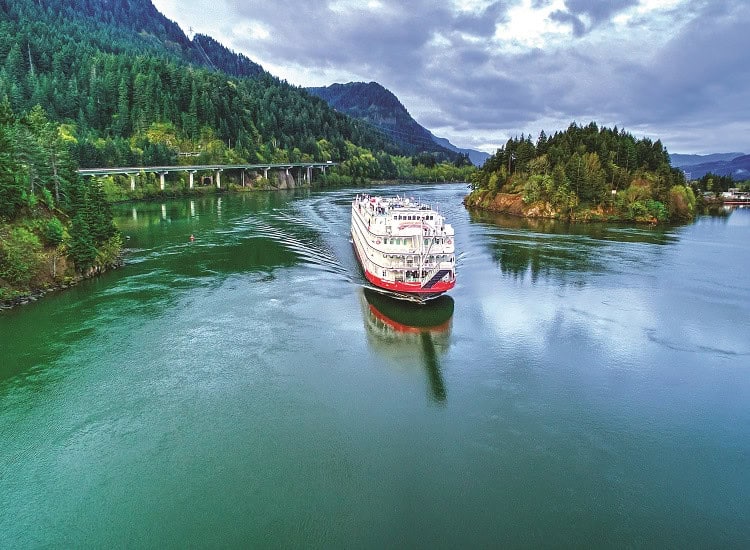
Key Features for Sailors
- Navigation Tips: The river’s lower sections are tidal, with strong currents near the mouth. Above Portland, the river transitions to controlled water levels, with dams and locks along the way. Nautical charts 18521 and 18524 are essential for navigating the estuary and lower river. Always monitor weather forecasts and river flow conditions, as winds can create choppy waters, particularly in the Columbia Gorge.
- Anchorages and Marinas:
- Astoria: Located near the river’s mouth, Astoria features a large marina with fuel, water, and repair services. Explore this historic town known for its maritime museums and Victorian architecture.
- Portland: With several marinas along the Willamette River (a Columbia tributary), Portland offers full-service facilities and access to the city’s vibrant culture and dining scene.
- Beacon Rock State Park: Located in the Columbia Gorge, this park has a small dock and trails leading to the iconic basalt monolith for stunning views.
- Best Times to Visit: Late spring through early fall provides the best conditions, with warmer temperatures and calmer waters. Fall offers beautiful foliage, while spring brings blooming wildflowers along the riverbanks.
Activities and Attractions
- On the Water:
- Sail the lower Columbia near Astoria, where wide estuaries make for scenic cruising.
- Navigate the locks at Bonneville Dam to experience the engineering marvels that make the river passable.
- Try fishing for salmon and sturgeon, both abundant in the river.
- On Land:
- Visit Mount Hood, just a short drive from Portland, for hiking and panoramic views.
- Explore Hood River, the region’s hub for wind sports and outdoor recreation, with plenty of dining and shopping options.
- Stop at The Dalles, a historic river town known for its Native American history and pioneer landmarks.
- Wildlife Watching: The river is home to osprey, herons, and bald eagles, as well as river otters and seals near the estuary. In the Columbia Gorge, keep an eye out for bighorn sheep on the cliffs.
Local Tips
- Provisions and Supplies: Astoria and Portland are the best locations to refuel and stock up on supplies. Smaller towns like Hood River and The Dalles also have limited services.
- Events and Festivals: Plan your visit around the Astoria Regatta in August or Hood River’s Harvest Fest in the fall to enjoy local culture and festivities.
- Environmental Considerations: Follow local guidelines for safely navigating locks and be cautious of protected areas near the riverbanks. Be mindful of wake zones to reduce erosion on the river’s fragile ecosystems.
Sailing in BC
Gulf Islands Sailing: Culinary Delights and Scenic Retreats
The Gulf Islands, located just north of the San Juan Islands in British Columbia, are known for their serene waters, vibrant arts communities, and exceptional culinary offerings. These islands are perfect for sailors seeking a mix of natural beauty and upscale amenities. With sheltered anchorages, calm sailing conditions, and breathtaking landscapes, the Gulf Islands are a haven for boaters looking to relax and explore.
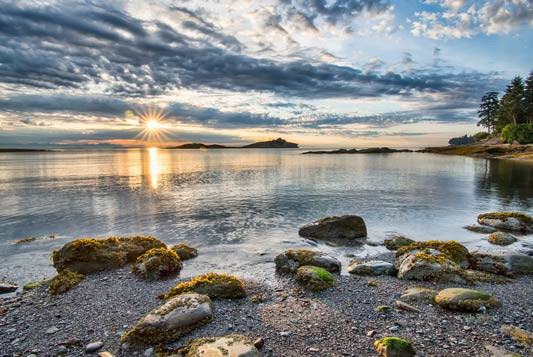
Key Features for Sailors
- Navigation Tips: The Gulf Islands are generally easy to navigate, with well-marked channels and protected waters. However, sailors should be cautious of strong tidal currents, particularly in Active Pass and around Gabriola Passage. Charts 3463 and 3441 are essential for navigating this region.
- Anchorages and Marinas:
- Ganges Harbour (Salt Spring Island): Full-service marina with moorage, fresh water, shore power, and nearby shops.
- Montague Harbour (Galiano Island): Offers a popular anchorage with nearby hiking trails and calm waters. Dinghy up to the shore for the famous “pub bus” ride to local dining spots.
- Bedwell Harbour (Pender Island): A favorite for customs clearance into Canada, with moorage facilities and nearby resort amenities.
- Best Times to Visit: June through September offers warm weather, calm waters, and plenty of sunshine. Fall and spring are quieter but still beautiful, with fewer crowds and lower moorage fees.
Activities and Attractions
- On the Water: Paddleboarding and kayaking are popular in sheltered coves, offering up-close views of seals and other marine life. Fishing enthusiasts can try their luck with salmon or rockfish.
- On Land: Salt Spring Island is the culinary heart of the Gulf Islands. Visit its famous farmers’ market for artisanal cheeses, fresh produce, and locally crafted wines. Explore Ganges Harbour’s boutique shops and art galleries, or hike to Mount Norman on South Pender Island for panoramic views.
- Wildlife Watching: The Gulf Islands are teeming with wildlife, from seals lounging on rocky shores to bald eagles soaring above. Otters and seabirds are frequently spotted near anchorages.
Local Tips
- Provisions and Supplies: Ganges Harbour is the best spot to stock up on fresh groceries and supplies, with markets, grocery stores, and marine shops nearby.
- Events and Festivals: Time your visit to coincide with Salt Spring Island’s Saturday Market or the Gulf Islands Film and Television School’s open house events.
- Environmental Considerations: Follow local guidelines to protect sensitive marine habitats. Avoid anchoring in areas marked for eelgrass restoration, and be mindful of marine life when kayaking or boating.
Sunshine Coast Sailing: Active Adventures and Relaxation
The Sunshine Coast, stretching along the mainland of British Columbia, is a stunning blend of rugged natural beauty and vibrant coastal communities. Accessible only by boat or ferry, this area is a haven for sailors looking to explore unspoiled waters, hike scenic trails, and enjoy the charm of artisan towns. The Sunshine Coast offers something for every traveler, from thrilling tidal rapids to tranquil beaches and lively local culture.
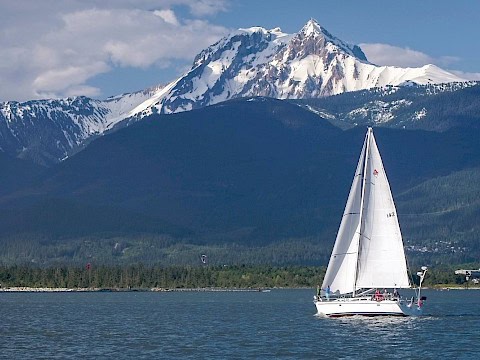
Key Features for Sailors
- Navigation Tips: The waters of the Sunshine Coast are well-charted and suitable for sailors of all experience levels. Be cautious around Skookumchuck Narrows, where tidal currents can reach up to 16 knots. Charts 3535 and 3537 are useful for navigating the coastline.
- Anchorages and Marinas:
- Gibsons Marina: A full-service marina with moorage, fuel, and repair facilities. Located near artisan shops and local eateries.
- Secret Cove Marina: A quiet and picturesque stop offering dock space, showers, and provisions.
- Pender Harbour: Known as the “Venice of the North,” this protected harbor has several anchorages and marinas, along with fuel, groceries, and marine supplies.
- Best Times to Visit: Late spring to early fall provides the best weather for sailing, with mild temperatures and calm seas. Avoid winter months, as storms and heavy rainfall can make conditions challenging.
Activities and Attractions
- On the Water: Explore the shoreline by kayak or paddleboard, or head to Smuggler Cove Marine Provincial Park for a scenic anchorage and gentle paddling. Fishing for salmon and prawns is also popular.
- On Land: The Sunshine Coast is packed with opportunities for hiking and biking. Popular trails include the Sunshine Coast Trail, which spans over 180 kilometers, and shorter options like the Soames Hill climb for panoramic views.
- Wildlife Watching: Keep an eye out for seals, sea lions, and even orcas in the waters. Bald eagles and herons are often seen along the shore, particularly near estuaries.
Local Tips
- Provisions and Supplies: Gibsons and Pender Harbour are the best spots to restock supplies, offering grocery stores, fuel, and marine services. Sechelt also has smaller shops and artisan goods.
- Events and Festivals: The Sunshine Coast hosts several vibrant events, including the Gibsons Landing Jazz Festival in June and the Sunshine Coast Art Crawl in October.
- Environmental Considerations: Practice safe boating near Skookumchuck Narrows to minimize your impact on this delicate tidal ecosystem. Be mindful of marine sanctuaries and use eco-friendly anchors to avoid damaging seabeds.
Desolation Sound Sailing: Serenity and Stargazing
Desolation Sound, located at the northern tip of British Columbia’s Sunshine Coast, is a secluded paradise renowned for its tranquility and natural beauty. With warm, crystal-clear waters and majestic mountain backdrops, this area is a favorite for sailors seeking a peaceful retreat. Known for its sheltered anchorages and incredible stargazing opportunities, Desolation Sound is the perfect destination to unwind and reconnect with nature.
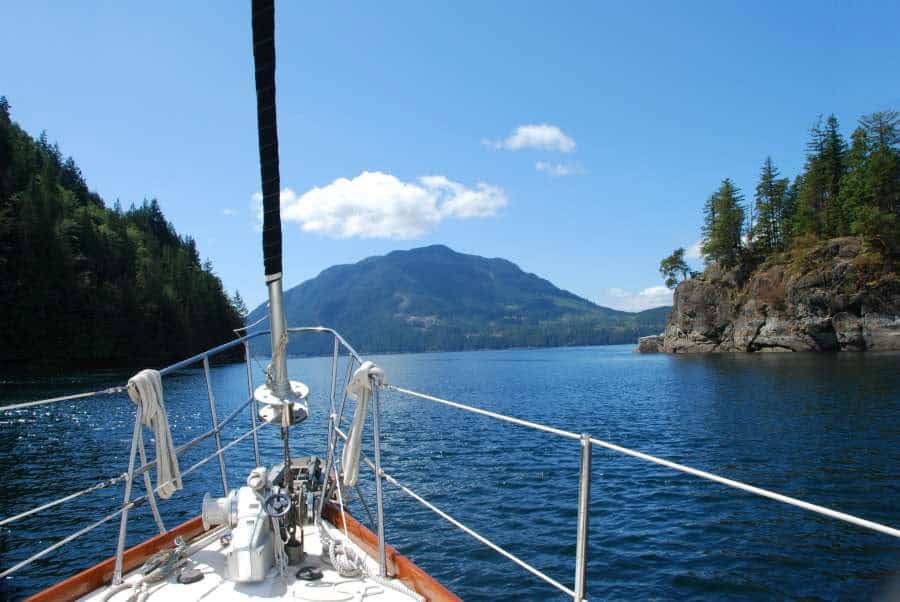
Key Features for Sailors
- Navigation Tips: The waters of Desolation Sound are calm and well-suited for sailors of all levels. Navigation is straightforward, but sailors should be aware of tidal changes and bring charts 3538 and 3539 to assist in plotting their course. Weather conditions are generally favorable during the summer months, with minimal winds.
- Anchorages and Marinas:
- Prideaux Haven: A popular and spacious anchorage offering calm waters and stunning views, perfect for overnight stays.
- Tenedos Bay: Known for its easy access to Unwin Lake, this anchorage is ideal for swimming, hiking, and kayaking.
- Refuge Cove: A small but charming marina with fuel, water, groceries, and supplies. It’s a great stop to restock before heading deeper into the sound.
- Best Times to Visit: Late June through September is the best time to visit, with warm temperatures and long daylight hours. Nights are cool and clear, ideal for stargazing.
Activities and Attractions
- On the Water: Enjoy the sound’s warm waters for swimming, snorkeling, and paddleboarding. Kayaking is particularly rewarding, allowing you to explore hidden coves and coastal nooks that larger vessels cannot reach.
- On Land: Hike to Unwin Lake from Tenedos Bay for a refreshing freshwater swim or explore the trails near Refuge Cove for a mix of forest and coastal views. The nearby Copeland Islands Marine Provincial Park offers opportunities for picnicking and wildlife spotting.
- Wildlife Watching: Look for seals, otters, and porpoises near your anchorages. Bald eagles are often seen perched on trees along the shoreline, and occasionally, dolphins and orcas make appearances in the sound.
Local Tips
- Provisions and Supplies: Refuge Cove is the primary spot to stock up on fuel, water, and basic groceries. For longer stays, bring ample provisions, as other supply points are limited.
- Events and Festivals: While Desolation Sound is mostly about peace and quiet, nearby communities like Lund host small summer markets and cultural events.
- Environmental Considerations: Respect the natural serenity of the area by minimizing noise and light pollution. Use biodegradable soaps and avoid anchoring near sensitive marine habitats to preserve the sound’s pristine environment.
Content creator and writer for multiple websites including All About Glamping, Fit Living Lifestyle, and Live Dream Discover. A full-time traveler who has spoken at various travel conferences around the world.

